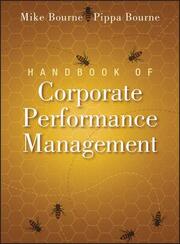Detailansicht
Handbook of Corporate Performance Management
ISBN/EAN: 9780470669365
Umbreit-Nr.: 1283340
Sprache:
Englisch
Umfang: 280 S.
Format in cm:
Einband:
gebundenes Buch
Erschienen am 30.09.2011
Auflage: 1/2011
- Zusatztext
- A thorough and comprehensive guide to measuring and managing the performance of businesses, understanding where you are, communicating where you want to be and managing towards your longer term strategic goals. Measuring performance in a way which is linked to strategy and measures the right activities is a process which few organizations undertake, but those which do reap substantial benefits in terms of increased success. Even fewer organizations can maintain and use their measurement system effectively, engaging the workforce in delivering success. This book will show readers how to do just that, using relevant examples from a variety of organizations including: * Tesco's 'steering wheel'- a means of displaying what is important to the organization from boardroom to store - Terry Leahy has attributed much of Tesco's success to their performance management approach * EDF Energy's highly innovative approach to cascading their 'success maps' down the organization, winning them a high degree of ownership and commitment to the organizational goals by involving people at all levels in the process Taking a practical approach, and including details of processes and tools that can be adopted and customized by any organization, the authors also include guiding principles to help readers avoid the pitfalls of inappropriate performance management. The book, uniquely, combines guidance on the practical use of frameworks such as the Balanced Scorecard, with the application of measures to manage performance.
- Autorenportrait
- InhaltsangabePreface xi Acknowledgements xiii Introduction xv 1. Performance and the Role of Measurement 1 1.1 Introduction 1 1.2 What is good performance? 1 1.3 Whose perspective? 1 1.4 Making comparisons 2 1.5 Present success and future sustainability 3 1.6 How is performance delivered? 3 1.7 The roles of a performance measurement system 5 1.8 The focus of measurement 7 1.9 The role of management and leadership 9 1.10 In summary 10 Further reading 10 2. Practical Tools for Measuring Performance 13 2.1 Introduction 13 2.2 Elements of a performance measurement system 13 2.3 The Balanced Scorecard 15 2.4 The Performance Prism 19 2.5 Objectives and success maps 20 2.6 Designing measures 24 2.7 Summary 30 Further reading 31 3. Designing the System 33 3.1 Introduction 33 3.2 A four phase life cycle 33 3.3 Design 34 3.4 How is this done in practice? 34 3.5 The debate 35 3.6 Developing the success map 37 3.7 Developing the measures 39 3.8 The next stage 40 Further reading 40 4. Managing Implementation 41 4.1 Introduction 41 4.2 Phases of implementation 41 4.3 Why does implementation succeed or fail? 41 4.4 Hurdles and blockers 45 4.5 Steps to successful implementation 46 4.6 Conclusion 48 Further reading 48 5. Assessing and Managing Change 51 5.1 Introduction 51 5.2 Change in context 51 5.3 Assessing resistance to change 53 5.4 Return on management 54 5.5 Assessing likelihood of implementation 55 5.6 Conclusion 58 Further reading 58 6. Target Setting 59 6.1 Introduction 59 6.2 Why do you set targets? 59 6.3 Ten common problems 60 6.4 The target setting wheel 62 6.5 Closing remark 65 Further reading 65 7. Linking Rewards to Performance 67 7.1 Introduction 67 7.2 Pitfalls 67 7.3 Linking rewards to performance 71 7.4 Examples 75 7.5 Summary 78 Further reading 78 8. Managing with Measures - Statistical Process Control 81 8.1 Introduction 81 8.2 Variation and our reaction 81 8.3 Statistical process control 83 8.4 Performance and performance improvement 91 Further reading 92 9. Using Measures - Performance Reviews 93 9.1 Introduction 93 9.2 The Performance planning value chain 93 9.3 Performance reviews 99 Further reading 104 10. Using Measures to Manage - Challenging Strategy 105 10.1 Introduction 105 10.2 Company examples 105 10.3 Testing success maps in practice 109 10.4 Testing in theory and practice 113 10.5 Behavioural issues 117 10.6 Conclusion 118 Further reading 118 11. Keeping Your Measurement Process up to Date 119 11.1 Introduction 119 11.2 Keeping the process up to date 119 11.3 When do you update targets? 119 11.4 Revising measures 122 11.5 Reviewing the measures in line with your success map 123 11.6 Reflecting on your strategy 124 11.7 Challenging strategy 125 11.8 Overcoming barriers to updating your system 126 11.9 Summary 133 Further reading 133 12. Measuring Performance of People 135 12.1 Introduction 135 12.2 Essential elements for high performance 135 12.3 Measuring employee satisfaction and engagement 136 12.4 Performance appraisals 141 12.5 HR performance measures 145 12.6 Acting on results 147 Further reading and sources of information 147 13. Measuring Customers 149 13.1 Introduction 149 13.2 What are you measuring? 149 13.3 Using customer feedback 157 13.4 Summary 160 Further reading 161 14. Measuring Process Performance 163 14.1 Introduction 163 14.2 A process framework 163 14.3 Process measurement 164 14.4 Key process measures 165 14.5 Summary 169 Further reading 169 15. Measuring Competence and Resource Development 171 15.1 Introduction 171 15.2 Defi ning terms 171 15.3 Why measure resource and competence development? 172 15.4 A framework for displaying the relationship b
